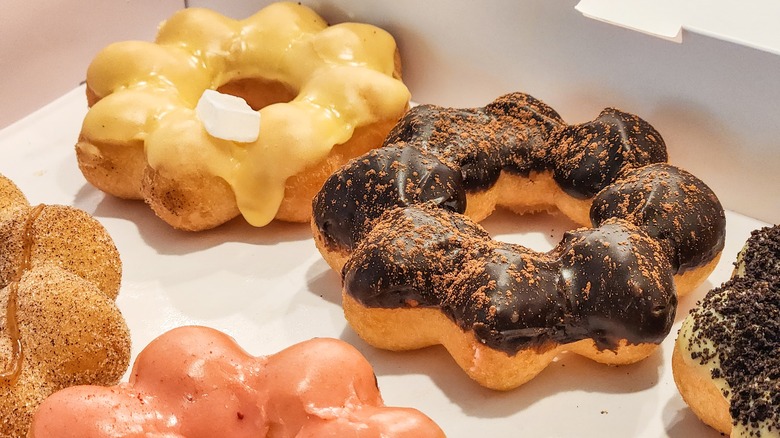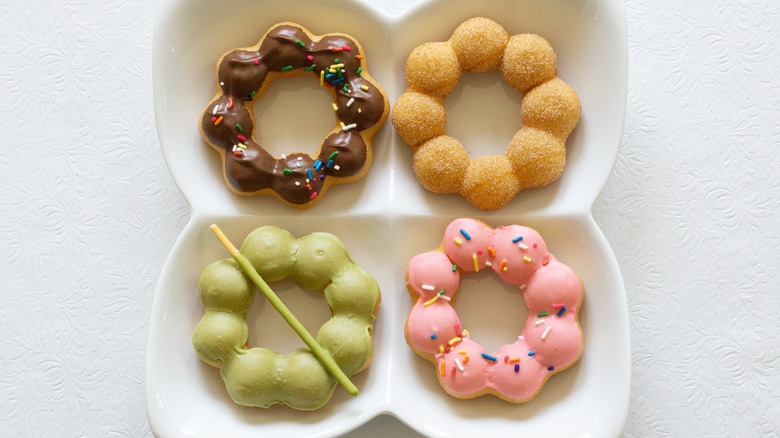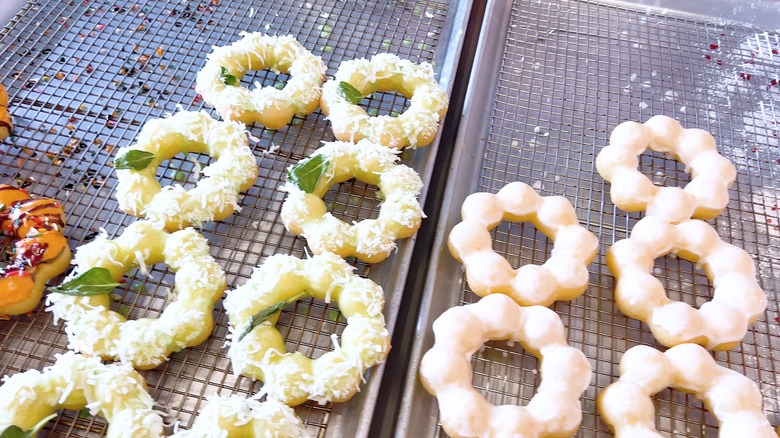How To Make Sure Your Mochi Donuts Are Nice And Chewy
You've probably heard of mochi ice cream, but have you ever tried a delicious mochi donut? A tasty fusion of the classic American donut and Japanese mochi, these mouthwatering pastries offer a satisfying chewiness that regular donuts lack and, like mochi ice cream, come in various tasty flavors and bright colors, like matcha green tea, black sesame, and cookies and cream. Mochi donuts have existed for decades in Hawaii and Japan but have only caught on in the U.S. in the last few years.
If you want to make your own sticky, gluten-free donuts at home, you'll first need to buy the right type of flour. Mochi is a traditional Japanese rice cake that's been around for centuries. It's made with glutinous rice flour, which is derived from a type of Japanese sticky rice called mochigome. Mochi donuts are made with glutinous rice flour and sometimes tapioca flour, which gives them their chewy, stretchy texture.
Besides choosing the correct flour, an important cooking tip to ensure your mochi donuts are nice and chewy is to continue to stir your dough on the stovetop until it becomes a sticky ball of dough. When you first add the flour to your liquid ingredients (butter, milk, egg, sugar, and salt) it'll start as a dry, clumpy mess, but as you keep stirring (for around two minutes) it'll eventually turn into a sticky, firm ball that'll give you perfectly chewy mochi donuts.
Pon de ring donuts vs. mochi donuts
Mochi donuts are typically made in a unique shape referred to as "pon de ring" — derived from the Spanish "pao de queijo" — a Brazilian cheese bread with a similar shape made with tapioca flour. The shape resembles a baby's teething ring, with eight small dough balls connected to make one scrumptious ring. Pon de ring donuts are often called mochi donuts because of their chewy, mochi-like texture, however, they are originally made with just tapioca flour and not mochi. True mochi donuts often have the pon de ring shape but are made with glutinous rice flour (sometimes combined with tapioca flour).
Both types of donuts are chewy, however, pon de ring donuts have an airier texture, while mochi donuts are denser. While both donuts are typically fried to give them a crispy outer shell, they can also be baked for a healthier alternative. Both tapioca flour and glutinous rice flour (despite its name) are gluten-free, making these donuts a great treat for those avoiding gluten.
One of the most appealing aspects of pon de ring and mochi donuts is that they are often coated in vibrantly colored glazes that taste just as glorious as they look. With the flowery ring design and fun flavors like mango, red velvet, Fruity Pebbles, peanut butter, and churro, these chewy donuts are much more than your standard sugar-glazed donut; they're mouthwatering works of art that appeal to kids and adults alike.
Who invented mochi donuts?
The origin of mochi donuts is somewhat complicated, though it has clear roots in Hawaii and Japan, as well as a connection to Brazil. The earliest creation of these chewy donuts can be traced back to poi mochi, small dough balls made with poi (mashed taro roots) and glutinous rice flour. Poi mochi is thought to have been invented in Hawaii by Charmaine Ocasek and is the pride and joy of Uncle Lani's, a Hawaiin cafe and self-proclaimed poi mochi innovator.
Fast forward to 2003 when, in Japan, Mister Donut — renowned for their interesting donut flavors — created the pon de ring donut inspired by a Brazilian chewy cheese bread. Finally, in 2016, drawing inspiration from the pon de ring and poi mochi, Liliha Bakery in Hawaii created a poi mochi donut in the signature 8-dough ball ring shape. Eventually, versions of this donut (generally without poi) caught on in the U.S. and are now being sold in donut shops across the country.
The tasty donuts are so popular that Mochinut — a business founded in 2020 that sells mochi donuts and other Asian-inspired treats — now has more than 140 locations in the U.S. Mochi donuts are likely available to buy in your area, or you can make your own, just remember to use the correct flour and stir your ingredients until it forms the ultimate chewy dough that — along with the unique flavors — is the trademark of these delicious donuts.


